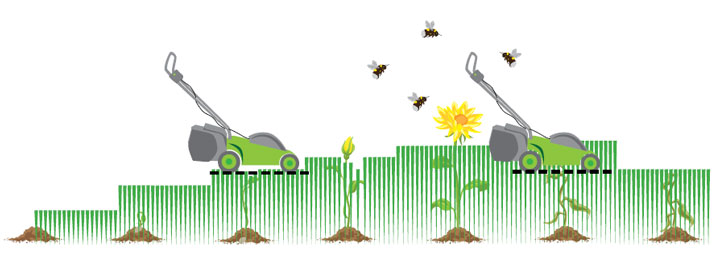Pollination Stations
In 2020 we finalised the Climate Emergency Strategy and Air Quality Action Plan, which both detail an ambition to beat climate change and reduce air pollution.
We have always been environmentally focused, with the conservation of ecology at the heart of how we deliver our service. However, with a local climate emergency being declared, we now have an exciting opportunity to identify and explore new environmentally sympathetic ways of working.
With this in mind we have designated Pollination Stations in some of our parks and open spaces. These Pollination Stations are grass areas which we are maintaining to naturalise.
About the management of Pollination Stations in parks and open spaces
Previously all amenity grass in parks and open spaces were managed between a height of 15mm to 70mm with all arisings (cuttings) left, which inhibited the growth of native flowering plants, increased soil nutrient levels and stimulated vigorous growth for coarse grasses. We believe that by leaving Pollination Stations, they will have significant potential and that by introducing an environmentally sympathetic approach to maintenance we can:
- Increase biodiversity
- Improve habitats for native flora and fauna
- Reduce our carbon footprint
- Improve air quality
Maintenance regime
We have introduced ‘Pollination Stations’ in the form of natural grass areas in various parks and open spaces. The Pollination Stations will be cut and collected bi-annually.
Pollination Stations
These Pollination Station areas meet all the criteria of our objectives:
- Increase habitat for pollinators
- Increase the biodiversity of flora and fauna
- Reduce our carbon footprint
- Improve air quality

The natural grass areas cut would typically only require two cuts, one in mid spring (April/May) and one in late summer (August/September). However, a third cut would also be carried out - if needed - in the winter (January/December).
Where possible arisings would be collected, but this would depend on growing conditions and the amount of arisings. For example, it may not be necessary to remove arisings on the winter cut, however the spring cut would need arisings removed as this is when competitive coarse grasses put on a lot of growth before they seed.
Benefits of this approach include:
- Many native plants present on the highway grass verges are annual (grown from seed, produce seed in one year and die). The cut provides annual plants the opportunity to complete their lifecycles and subsequently increase in population
- An increase in flowering native plants provides improved food source for pollinators
- The collection of arisings after the plants have completed their lifecycles removes nutrients from the soil, slowing the growth of competitive coarse grasses. It also allows more light and air for native flowering plants, therefore improving their chances of success
- Autumn can be warm and wet, which is ideal for grass growth. Removal of this late flush of grass can improve conditions for native flowering plants by reducing the competition for space and light
- Improved soil health and reduced compaction increases the resilience of highway grass verges to drought and flooding, subsequently reducing the impact this may also have to people and property
Our reason for this approach
This new environmentally sympathetic approach to managing the highway grass verges is being introduced to help achieve our Climate Emergency Strategy and Air Quality Action Plan.
This is not a cost cutting exercise, we are working differently, not less. Equipment needed to cut longer grass costs considerably more, however the environmental gains far outweigh this cost.
Parks and open spaces with Pollination Stations
You can find Pollination Stations in the following parks and open spaces:
Up to: Latest parks updates
Updated: 16 July 2025
 Stay up to date! Make sure you subscribe to our email updates.
Stay up to date! Make sure you subscribe to our email updates.
